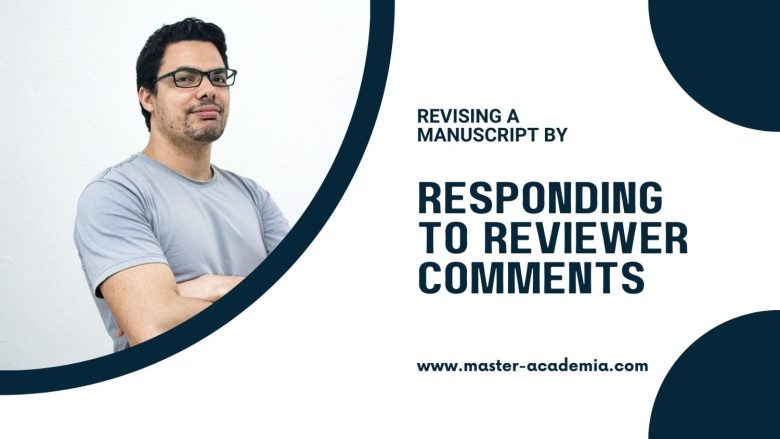
Publishing scientific articles in academic journals is a lengthy process. Even when manuscripts are accepted, most have to undergo major or minor revisions before being published. This guide explains how to best revise your manuscript and respond to reviewer comments.
Disclosure: This post may contain affiliate links, which means I may earn a small commission if you make a purchase using the links below at no additional cost to you. I only recommend products or services that I truly believe can benefit my audience. As always, my opinions are my own.
Contents
The importance and challenges of revising manuscripts
Manuscripts are hardly ever accepted for publication without any revisions. In fact, a manuscript has to go through many stages before it is published, and revising it is an essential part of this process.
Receiving minor and even major revisions is a cause for celebrations: It means that a paper will most likely be published.
First, however, your paper has to be improved. The whole peer review system has been established to uphold academic standards and academic integrity. While revising a manuscript can be annoying, the end result is often an improved academic paper.
Authors tend to receive feedback from at least two external reviewers. This feedback can range from several bullet points to several pages of written text. Editors want to see that authors take these reviewers’ comments seriously, and change their manuscript accordingly.
Reading critical feedback on a manuscript can be upsetting and emotionally challenging. Additionally, reviewers may ask for many different changes and can even have conflicting opinions. It is easy to feel overwhelmed, but the following steps make the process easier.
You may also like: How to deal with a desk-rejected paper
Step 1: Take time to read and digest reviewer comments
There is a proper way to write peer reviews. Unfortunately, however, many peer reviewers still provide feedback in a hurtful and unconstructive way. If you haven’t experienced it yourself, you may have heard jokes about the infamous and mean Reviewer #2.
If you are unlucky, reviewers’ comments can be disheartening. This makes it extra hard to open your documents and to start working on it. Even if reviews are constructive, the sheer amount or type of changes that are requested can feel overwhelming.
Therefore, make sure to take proper time to read and digest all feedback. Sometimes it is easier to distribute this task over several days.
Step 2: Turn reviewer comments into actionable steps
The next step is to turn lengthy reviewer comments into actionable steps. You do not want to read the whole peer review over and over again while working on revising your manuscript.
There are several ways to do this. The easiest way is to create a table for each reviewer, with a column for each point that the reviewer raises, and one to explain how you address the comment in your revision. (You can also opt for categorising the comments thematically, or in line with different sections of your paper.)
| Reviewer comment | Change / answer |
|---|---|
Start filling the reviewer comments into the left column. Split up the feedback you received into concrete tasks. For instance, if a reviewer wrote general feedback about how difficult it is to follow your theoretical framework, copy-paste the relevant text into one row. If a reviewer made a specific suggestion of what literature to add, copy-paste the relevant text into the next row.
Continue until you have all the feedback of the first referee covered, and included in your table. Then, do the same for all other reviewers.
While turning reviewer comments into actionable steps in your table, try to omit lengthy text. Maybe one reviewer went on and on about how chaotic your analysis section is. You got the point and it does not help you to include it several times in your table.
If you have reviewer comments that are extremely elaborate, it might be helpful to include one more column in your table: The key takeaway. You can copy-paste a large paragraph that the reviewer wrote in the first column. Then you can indicate the key takeaway in the middle column. The key takeaway could be, for example:
“The argumentation in the theoretical framework is difficult to follow.”
| Reviewer comment | Key message | Change / answer |
|---|---|---|

If you are looking to elevate your writing and editing skills, I highly recommend enrolling in the course “Good with Words: Writing and Editing Specialization“, which is a 4 course series offered by the University of Michigan. This comprehensive program is conveniently available as an online course on Coursera, allowing you to learn at your own pace. Plus, upon successful completion, you’ll have the opportunity to earn a valuable certificate to showcase your newfound expertise!
Step 3: Tackle one comment at a time
Once you have your tables completed, you know what to do. Set yourself a timeline to process the comments and to revise your manuscript accordingly.
You may decide to get the revisions done as soon as possible, and set aside three or four full days to work on it. Or you may decide to tackle two comments each day. Thus, if you have 30 different comments (or action points) in your table, you can spread it out over three weeks. Do what works best for you.
When addressing a comment, first read it comment again. Then decide how to address it. Some comments are easier to address than others. Think about how you can revise your manuscript in light of the specific feedback, and keep track of your actions in the right column of the table.
For instance, responding to a reviewer complaining about a theoretical framework that is difficult to follow, you can answer the following:
| “Thank you for the feedback. I realise that my framework is very complex. In order to make my framework easier to understand, I included a conceptual figure in the paper. Furthermore, I added sub-headings in the theoretical section to clarify my line of argumentation.” |
Then, of course, make the changes in your actual manuscript. Track your changes in the document, so that the editor can see what you changed in the text.
And yes, you can disagree with reviewer comments! But make sure to acknowledge the feedback and to provide a (polite!) rebuttal, explaining why you disagree. And always double check if there is not anything you can do to at least slightly address each reviewer comment.
Step 4: Resubmit your manuscript
It may take a while to complete your revisions and to address all reviewer comments, but the table will guide you through the work. And you will see the progress that you make.
Once you are finished, and happy with the new version of your paper, it is time to resubmit. First of all, complete the document with the tables with reviewer comments and changes/answers.
Write a short thank you note at the beginning of the document, thanking the reviewers for their feedback. Also thank the editor of he or she made some content-related suggestions as well.
You may not feel like thanking a reviewer who was mean and unconstructive. But remember that the editor will have a look at the document and ultimately decide whether your manuscript will be published or not. So be the bigger person and be professional. No need to lie and thank the reviewer for constructive and valuable feedback if it was neither. But thank them for their feedback nonetheless.
Secondly, prepare two documents of your manuscript:
- One in which all track changes are visible.
- One that is cleaned up, without visible track changes.
Finally, submit your revised manuscript, as well as your “reviewer comments and answers” document.
Bravo, you did it!



